商学部(塾外用) - 慶應義塾大学-塾生HP
商学部(塾外用) - 慶應義塾大学-塾生HP
商学部(塾外用) - 慶應義塾大学-塾生HP
You also want an ePaper? Increase the reach of your titles
YUMPU automatically turns print PDFs into web optimized ePapers that Google loves.
DEVELOPMENT AND SOCIAL CHANGE 2credits (Spring)<br />
開発と社会変容 2単位 (春学期)<br />
Effect of Development Policy and Social Change at Grass-roots<br />
Community in Indonesia<br />
Professor, Faculty of Economics KURASAWA, AIKO<br />
経済学部教授 倉沢 愛子<br />
Course Description:<br />
I will describe social changes brought by rapid and heavy development<br />
policy, taking a case of Indonesia. My analysis is based on field research<br />
in two sites (one urban and another rural) where I have been watching<br />
since 1996. I will focus on changes on such aspects as human relations<br />
within the community, flow of information and changes in<br />
communication mode, religious piety, life-style etc. I will show you video<br />
which I recorded at the research sites.<br />
Through this course first of all I want you to get clear image on<br />
people’s life in a relatively “unknown” world, and so doing, to reconsider<br />
such questions as what is “development” and what is “prosperity. Does<br />
economic development really bring you prosperity and happiness ?<br />
Critical analysis and evaluation are most welcome.<br />
Reference Books:<br />
Kurasawa, Aiko, Jakarta Rojiura Field Note, Chuokoronshinsha 2001<br />
WORLD OF SOUTHEAST ASIA 2credits (Fall)<br />
東南アジア世界の諸相 2単位 (秋学期)<br />
Understanding Contemporary & Historical Aspects<br />
Professor, Faculty of Policy Management NOMURA, TORU<br />
総合政策学部教授 野村 亨<br />
Course Description:<br />
In this class, students are exposed to contemporary as well as historical<br />
aspect of Southeast Asia. The information acquired in this lecture will<br />
surely be quite useful for those who want to be engaged in business in this<br />
fast-developing region.<br />
Textbooks:<br />
None. Handouts will be given from time to time by way of the attached<br />
file in the e-mail.<br />
Reference Books:<br />
Several books will be suggested during the class.<br />
CONSTRUCTING INDIA 2credits (Spring)<br />
インドをソウゾウする 2単位 (春学期)<br />
Indian and Japanese Perspectives and Policies<br />
Lecturer WILLIAMS, MUKESH K.<br />
講師 ウィリアムス, ムケーシュ<br />
Course Description:<br />
India is a fast developing economy and a nuclear nation with ambitions<br />
to become an Asian and a global leader. It is keen to address some of the<br />
colonial ills such as a cumbersome bureaucracy and suspicion of<br />
globalization by establishing new economic and political ties with Japan<br />
and the rest of the world. What significance does this have for Japan and<br />
the rest of the world can only be understood if we delve into its ancient<br />
past and understand its present aspirations. Japan is now keenly looking<br />
towards India as a new partner in the areas of both business and strategic<br />
defense. In August 2007, the former Japanese prime minister Shinzo Abe<br />
visited India as part of an emerging Japanese policy to build a bilateral<br />
relationship between India and Japan. He gave a speech entitled, "Futatsu<br />
no umi no majiwari" (http://www.mofa.go.jp/region/asia-paci/pmv0708/<br />
speech-2.html) where he outlined his concepts relating to the history of<br />
Japan-India contacts over the centuries. The title of the speech came from<br />
a 17th century book Confluence of the Two Seas by a Mughal prince Dara<br />
Shikoh and was therefore replete with references to Indian culture. Some<br />
commentators saw the speech as a "paradigm shift" in Japan's foreign<br />
policy with India. (For more information see: http://japanfocus.org/<br />
81<br />
products/details/2514) As part of this visit and policy, Japan became an<br />
official partner in the Delhi-Mumbai Industrial Corridor Project (DMIC)<br />
agreeing to finance 30 billion USD of the project. (For more information<br />
see: http://commerce.nic.in/PressRelease/pressrelease_detail.asp?<br />
id=2090). Yet there is a wide gap between government policies and public<br />
awareness, particularly as it relates to modern Indian society, politics,<br />
economics, identities, caste and class. To bridge this gap, there is a need<br />
within the Japanese academic context to focus on these changing patterns<br />
in India since the last century and their impact on the contemporary<br />
geographical, political and economic region, especially Japan. This course<br />
will use an interdisciplinary approach to explore the shifting contours of<br />
India's past by focusing on the Indian economy, nuclear program, hard/<br />
soft identities, literatures and languages. It will not provide a simplistic<br />
solution by employing a unified "grand" narrative but explore multiple<br />
narratives to reveal the fragmentariness of the Indian experience.<br />
Beginning with an examination of the histories of an Indian past, the<br />
course will proceed through lectures by representatives of the Indian and<br />
Japanese communities and the academia to develop a more<br />
comprehensive perspective of India and the historical and cultural<br />
connections that inform Japan’s policies today.<br />
The class will be conducted in English and reading and writing will be<br />
primarily in English.<br />
Grades are also based on attendance and classroom participation.<br />
Textbooks:<br />
Williams, Mukesh and Wanchoo Rohit.(2008) Representing India:<br />
Literatures, Politics, and Cultures.New Delhi:Oxford University Press.<br />
ISBN:978-0-19-569226-8<br />
Reference Books:<br />
Sarkar Sumit. (2002) Beyond Nationalist Frames. Delhi: Permanent<br />
Black. ISBN: 978-8178240862<br />
COMMUNITY DEVELOPMENT AMONG DEPRESSED<br />
MINORITIES IN JAPAN AND INDIA 2credits (Spring)<br />
被差別マイノリティのまちづくり:日印比較 2単位 (春学期)<br />
Cross-cultural Studies between Japan and India<br />
Lecturer NISHIMURA, YUKO<br />
講師 西村 祐子<br />
Course Description:<br />
This course intends to give a comparative cross cultural analysis<br />
between two prominent countries in Asia: Japan and India. Studying<br />
societies from the grassroots level at the bottom of social strata, students<br />
are required to analyze the relationship between the socio-cultural stigmas<br />
and politico-economic power hierarchies. Students will learn not only<br />
the problems, but also the transformations of these communities in the<br />
21st century. What are the changes and how are these changes taking<br />
place? The first six classes will discuss issues related to Japan’s Ex-<br />
Untouchables (Burakumin), the urban poor (the homeless, internet café<br />
refugees, flophouse district residents, ethnic minorities such as resident<br />
Koreans, the Ainus, Okinawans and the recent immigrant minorities from<br />
overseas. The second component of the course will discuss India’s<br />
depressed minorities particularly the Ex-Untouchables and the Excriminal<br />
tribes, women, slum dwellers and the poor in rural areas. What<br />
are the problems surrounding them and how are these issues being dealt<br />
with by the government and NGOs? What are the keys to solve the<br />
problem? This course intends to provide students with a socio-cultural<br />
understanding necessary to understand social change in societies.<br />
Textbooks:<br />
Japan's Minorities: The Illusion of Homogeneity, ed. by M. Weiner,<br />
Routledge, ISBN0415130085<br />
Civic Engagement in Contemporary Japan: Established and Emerging<br />
Repertoires, eds. by Henk Vinken, Yuko Nishimura et. al.,<br />
Springer1441915036<br />
Reference Books:<br />
Karner, C. Ethnicity and Everytay Life, Routledge, 2006.<br />
Edward, L. In Spite of The Gods. Abacus, 2006.<br />
Pekkanen, R. Japan's dual civil society: members without advocates,<br />
Stanford Univerity Press, 2000.<br />
諸<br />
研<br />
究<br />
所




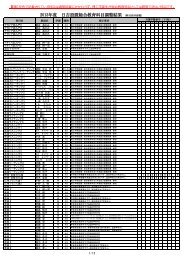
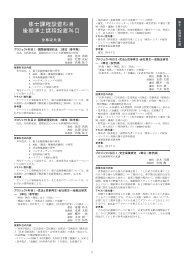
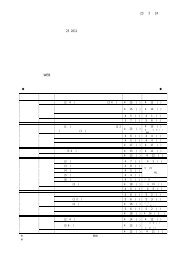
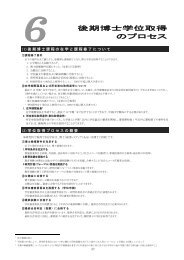
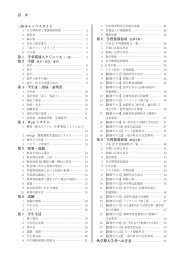



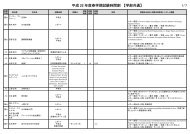

![文学部時間割表[2 ・3年生(07学則)]](https://img.yumpu.com/21046130/1/184x260/2-307.jpg?quality=85)

